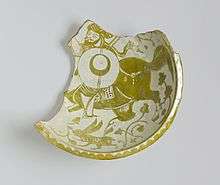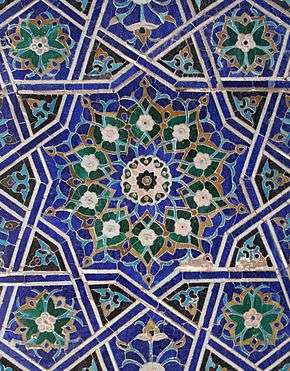Lusterware




Lusterware or Lustreware (respectively the US and all other English spellings) is a type of pottery or porcelain with a metallic glaze that gives the effect of iridescence, produced by metallic oxides in an overglaze finish, which is given a second firing at a lower temperature in a "muffle kiln", reduction kiln, which excludes oxygen.
Pre-modern wares
The first use of lustre decoration was as painting on glass.[2] While some scholars see this as a purely Islamic invention originating in Fustat,[3] others place the origins of lustre decoration in Roman and Coptic Egypt during the centuries preceding the rise of Islam. Staining glass vessels with copper and silver pigments was known from around the 3rd century AD,[4] although true lustre technology probably began sometime between the 4th and 8th centuries AD.[5][6]
Lustre glazes were applied to pottery in Mesopotamia in the 9th century; the technique later became popular in Persia and Syria.[7] In the Great Mosque of Kairouan, Tunisia, the upper part of the mihrab is adorned with polychrome and monochrome lusterware tiles; dating from 862-863, these tiles were most probably imported from Mesopotamia.[8][9] Islam forbade the use of precious metal dishes and vessels for eating, which had been normal for pre-Islamic elites, and there was therefore a market for elaborate and expensive glass and ceramic equivalents. The reminiscence of shining metal, especially gold, made lustreware especially attractive.[10]
Lusterware was produced in quantity in Egypt during the Fatimid caliphate in the 10th-12th centuries. While the production of lusterware continued in the Middle East, it spread to Europe through Al-Andalus. Málaga was the first centre of Hispano-Moresque ware, before it developed in the region of Valencia, and then to Italy, where it was used to enhance maiolica. In the 16th century lustred maiolica was a specialty of Gubbio, noted for a rich ruby red, and at Deruta.[11]
After a gap of several centuries in Persian production, it was revived in the Safavid period from about the 1630s, in a rather different style, typically producing small pieces with designs often in a dark copper colour over a dark blue (cobalt) background. Unlike other Persian wares of the period, these use traditional Middle Eastern shapes and decoration rather than Chinese-inspired ones, and also do not take their shapes from metalware. Designs featured plant forms and animals, and generally flowed freely over the whole surface, typically taking up over half the surface area. Production, which was never large, appears to have mostly been from about 1650-1750, but with rather inferior wares produced into the 19th century. It is often thought to have been centred in Kirman, though firm evidence is lacking.[12]
English and American lustreware
Metallic lustre of another sort produced English lustreware, which imparts to a piece of pottery the appearance of an object of silver, gold or copper. Silver lustre employed the new metal platinum, whose chemical properties were analyzed towards the end of the 18th century, John Hancock of Hanley invented the application of a platinum technique, and "put it in practice at Mr Spode's manufactory, for Messrs. Daniels and Brown",[13] about 1800. Very dilute amounts of powdered gold or platinum were dissolved in aqua regia[14] and added to spirits of tar for platinum and a mixture of turpentine, flowers of sulfur and linseed oil for gold. The mixture was applied to the glazed ware and fired in an enameling kiln, depositing a thin film of platinum or gold.[15]
Platinum produced the appearance of solid silver, and was employed for the middle class in shapes identical to those uses for silver tea services, ca. 1810-1840. Depending on the concentration of gold in the lustring compound and the under slip on which it was applied, a range of colours could be achieved, from pale rose and lavender, to copper and gold. The gold lustre could be painted or stenciled on the ware, or it could be applied in the resist technique, in which the background was solidly lustred, and the design remained in the body color. In the resist technique, similar to batik, the design was painted in glue and size in a glycerin or honey compound, the lustre applied by dipping, and the resist washed off before the piece was fired.
Lustreware became popular in Staffordshire during the 19th century, where it was also used by Josiah Wedgwood, who introduced pink and white lustreware simulating mother o' pearl effects in dishes and bowls cast in the shapes of shells, and silver lustre, introduced at Wedgwood in 1805. In 1810 Peter Warburton of New Hall patented a method of transfer-printing in gold and silver lustre. Sunderland Lustreware in the North East is renowned for its mottled pink lustreware, and lustreware was also produced in Leeds, Yorkshire, where the technique may have been introduced by Thomas Lakin.[16]
Wedgwood's lusterware made in the 1820s spawned the production of mass quantities of copper and silver lustreware[17] in England and Wales. Cream pitchers with appliqué-detailed spouts and meticulously applied handles were most common, and often featured stylized decorative bands in dark blue, cream yellow, pink, and, most rare, dark green and purple. Raised, multicolored patterns depicting pastoral scenes were also created, and sand was sometimes incorporated into the glaze to add texture. Pitchers were produced in a range of sizes from cream pitchers to large milk pitchers, as well as small coffeepots and teapots. Tea sets came a bit later, usually featuring creamers, sugar bowls, and slop bowls.
Large pitchers with transfer printed commemorative scenes appear to have arrived around the middle of the 19th century. These were purely decorative and today command high prices because of their historical connections. Delicate lustre imitating mother-of-pearl was produced by Wedgwood and at Belleek in the mid-century, derived from bismuth nitrate.[18]
Under the impetus of the Aesthetic Movement, William de Morgan revived lustrewares in a manner drawing from lustred majolica and Hispano-Moresque wares, with fine, bold designs.[19]
In the United States, copper lusterware became popular because of its lustrousness. Apparently, as gaslights became available to the rich, the fad was to place groupings of lusterware on mirror platforms to be used as centerpieces for dinner parties. Gaslights accentuated their lustrousness.

See also
Notes
- ↑ "Medieval & Renaissance Highlights - Makers and Markets". Medieval and Renaissance. Victoria and Albert Museum. Retrieved 2007-08-17.
- ↑ http://www.britishmuseum.org/explore/highlights/highlight_objects/me/l/lustre_painted_bowl.aspx
- ↑ Pinder-Wilson, R. 1991. The Islamic Lands and China. In: H. Tait (ed.), Five Thousand Years of Glass. London: British Museum Press, 112-143; p. 124.
- ↑ Carboni, S. 2001. Glass from Islamic Lands. London: Thames & Hudson, Ltd., p. 51.
- ↑ Caiger-Smith, p. 24.
- ↑ Pradell, T., Molera, J., Smith, A.D., Tite, M.S. 2008. The Invention of Lustre: Iraq 9th and 10th centuries AD. Journal of Archaeological Sciences 35, 1201-1215, p. 1201.
- ↑ Ten thousand years of pottery, Emmanuel Cooper, University of Pennsylvania Press, 4th ed., 2000, ISBN 0-8122-3554-1, pp. 86–88.
- ↑ Catherine Hess, Linda Komaroff and George Saliba (2004), The arts of fire: Islamic influences on glass and ceramics of the Italian Renaissance, Getty Publications, p. 40
- ↑ Mihrab of the Great Mosque of Kairouan (Qantara mediterranean heritage)
- ↑ Caiger-Smith, 24-31
- ↑ Caiger-Smith, Chapters 6-8
- ↑ Caiger-Smith, 80-84; Blair & Bloom, 171
- ↑ Hancock's memoir, quoted by Ross Taggart, The Frank P. and Harriet C. Burnap Collection of English Pottery in the William Rockhill Nelson Gallery, rev. ed. (Kansas City) 1967, p. 167.
- ↑ Aqua regia, a mixture of nitric and hydrochloric acid.
- ↑ Technical description from Taggart 1967:168.
- ↑ Taggart 1967:169.
- ↑ Silver was produced from platinum salts; fully lustred teasets imitating silver models were introduced in 1823 for middle-class households (L.G.G. Ramsey, ed. The Connoisseur New Guide to Antique English Pottery, Porcelain and Glass p. 70.
- ↑ John Fleming and Hugh Honour, Dictionary of the Decorative Arts, 1977, s.v. "Lustre".
- ↑ Caiger-Smith, 168-170
References
- Blair, Sheila, and Bloom, Jonathan M., The Art and Architecture of Islam, 1250–1800, 1995, Yale University Press Pelican History of Art, ISBN 0300064659
- Caiger-Smith, A., Lustre Pottery: Technique, Tradition and Innovation in Islam and the Western World, 1985, Faber & Faber
- John, W.D., and Warren Baker, Old English Lustre Pottery (Newport), n.d. (ca 1951).
External links
| Wikimedia Commons has media related to Lustreware. |
- Nishapur: Pottery of the Early Islamic Period, an exhibition catalog from The Metropolitan Museum of Art (fully available online as PDF), which contains material on lusterware
